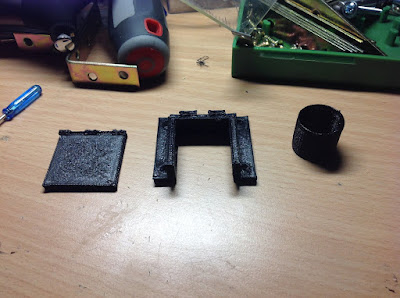Hello at all!
So my summer holidays ended 3 weeks ago and because I have my A levels this year I was pretty tied up in school. I'm also learning how to drive at two days of the week in the afternoon. As you can guess there is not much time to work seriously on a 3d printer. But on the weekends I took my time and finished reprinting my entire plastic parts. They were originally printed on my first printer, which had, let's be gentle, a quite medium quality finish. On top of that the X and Y axis were shifted at nearly a degree.
Yeah, I was happy with those parts....

...as long as I saw what my new printer was capable of and then decided to rework the whole design.
###
About the new design:

I'm thinking about making it open source, so everyone can build one themselves in their own shop or something like that. Open source is awesome, I really like the way of sharing work for free.
On the other hand I considered making it open source, but only with a private use. I don't know yet. But what I know is that you will be able to download the files and use them for your own projects.
When the 3d printing stuff on my 3d printer is working fine I'm planning to continue in the same way. I'm planning to make a interchangeable toolhead for not only 3d printing gear but also for pcb-milling, small laser diodes and pick and place/solderpaste dispensing. Since the motion system is already there with everything to make it run, I only have to tweak a few things, mod the marlin firmware and have a tiny all-round prototyping factory in my bedroom :) (Yeah kind of like the
>>fire pick delta<< from hackaday but as a corexy. I don't want to make a clone. I just came up with this thought when my printer was running and I thought about how awesome it would be if everything else from my projects can as easily be made as my mechanical parts)
###
I made it more easy to assemble and better in terms of stability and accessibility. I began printing in my last week of summer holidays, printed one to two parts per day and continued it on the weekends when school had started.

Now I'm finally done and can begin assembling it.
This is what it looks like now(the screws are of course not printed):

To give you a idea about speed: every piece took 14h (2 x 7h)
Casing
Because of the quite noisy sounds a 3d printer, or better MY 3d printer, makes, I decided to build a wooden casing with sound-filtering foam an ventilation. My aim was to make the whole thing so quiet that I could let it run over night and be sleeping in the same room.
Of course I couldn't make that work. As always when I think about things to build, I'm way to optimistic and euphoric. I would compare myself to an eight-year-old at christmas. I only see how awesome things could be and mostly repress the difficulties I have to face.
Yes, the casing is made out of wood and ventilated.
Yes, it cancels out the sound, but only some of it. It is so quiet that, if I'm in the same room and have music playing, I hardly notice it printing. But over night this is far too noisy to sleep next to.
The front and back panels are detachable and the top has a little plexiglass window in it with optional sound foam.
While making those my room kinda looked like I was building an professional recording studio ;)
Furthermore: I hooked up a spare raspberry pi I had around with octoprint. It works like a charm, I can access my printer from anywhere on the network with any device an check my print. It is super easy and a great help for me.
Thanks for reading!
Cheers,
JHL






































